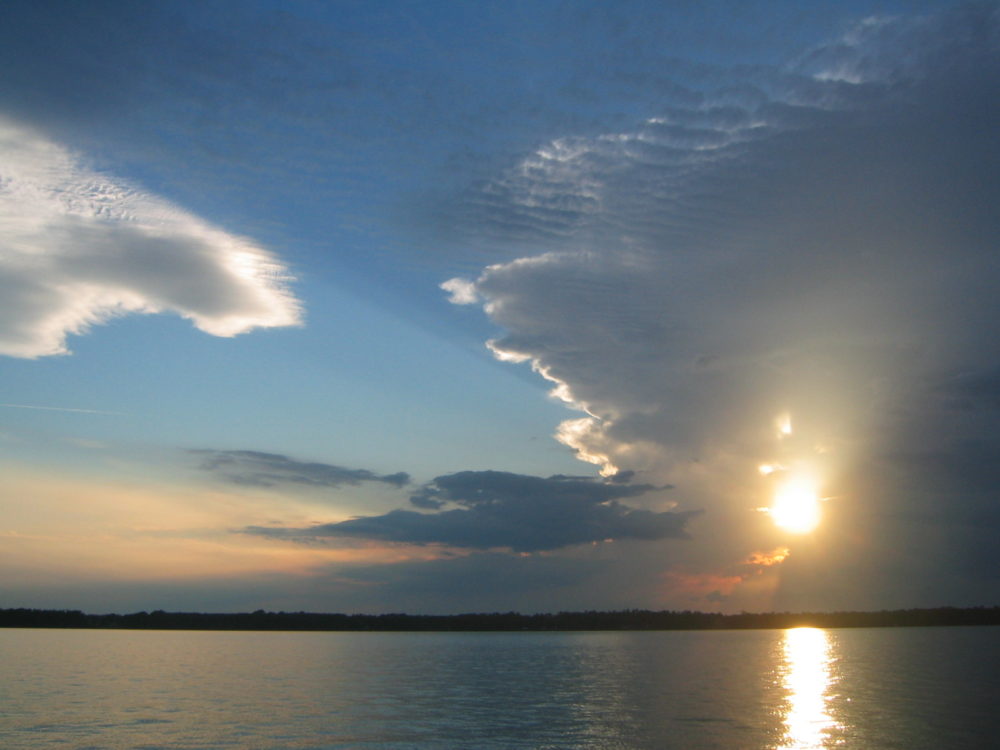Simple Tips to Help Protect Your Own Piece of Paradise!
Shoreline Vegetation
Probably the most beneficial thing we as homeowners can do for our lake is to maintain a healthy, naturally vegetated shoreline. This vital buffer where land and water meet filters lake water and the runoff from our activities on land. Natural shorelines can be both attractive and functional. Beach sand and sea walls are no longer permitted because they eliminate healthy shoreline vegetation, invite the introduction of invasive species, and endanger our fish habitat.
Aquat ic Vegetation
ic Vegetation
In Lake Santa Fe & Little Lake Santa Fe submerged aquatic vegetation (plants that grow completely underwater) is not very prolific. However, emergent aquatic vegetation (plants that grow in the water but generally have their leaves in the air, such as maidencane) is quite prevalent along our shoreline. Because submersed plants are so sparse, the emergent plants are the most important vegetation component of the aquatic habitat of our lake. They provide the basis of the food chain, which supports aquatic life on our lake. These plants provide food and critical habitat for fish and wildlife, and act as “kidneys” by filtering runoff from surrounding uplands.
Invasive Plants
It is said that each year Florida loses more natural habitat to invasive species than to new development! With few native pests and diseases to keep them in check, exotic plants can quickly displace native plants, disrupt wildlife habitat and clog waterways. Many invasive species readily adapt to the disturbed areas created when we clear our shorelines.
In 2002, Adopt-A-River volunteers conducted a shoreline plant survey of all properties on the Alachua County side of the lake. The results of the survey showed that Wild Taro (see below) is spreading at an alarming rate along much of our lakeshore. Found in large numbers in the Earleton area was Sesbania, while Little Lake Santa Fe has increasingly large numbers of Chinese Tallow trees. Two other aggressive invasive plants that have recently appeared are Japanese Climbing Fern and Tropical Soda Apple.
Examples of Invasive Exotic Plants to Avoid:
| Water Hyacinth | Water lettuce | Japanese Climbing Fern |
| Camphor Tree | Air Potato | Cat’s Claw Vine |
| Chinese Tallow Tree | Sesbania | Coral Ardesia |
| Torpedo Grass | Wild Taro | Shrub Lantana |
| Tropical soda apple | Kudzu | Japanese Honeysuckle |
| Nandina | Mimosa | |
Native Plants
Like groundcover and mulch, properly placed native plants require less effort to maintain, and decrease the need for fertilizers, pesticides, and water. They provide habitat for the birds and other animals that thrive in our ecosystem.
For more information on invasive and native plants, visit the websites for the University of Florida (http://edis.ifas.ufl.edu/topics/environment/plants.html) and the Florida Fish and Wildlife Conservation Commission (http://myfwc.com/wildlifehabitats/). The Florida Exotic Pest Plant Council website also contains helpful information: http://www.fleppc.org .
Phosphorus and Nitrogen
Major factors that cause algae blooms and other problems in Florida lakes are excess phosphorus and nitrogen. Both are found in fertilizers. While a dark green lawn may be aesthetically pleasing, we have to understand that these lawns also contribute to the degradation of our lake. Fertilizing just one lawn does not cause major harm, but if the more than 700 parcel owners on the lake fertilize their yards, we can expect to see our lake water quality decrease over time.
Septic Tanks
Septic tanks are a necessity of life on Lake Santa Fe, but there are ways we can minimize their impact. The use of phosphate-free detergents in the laundry and kitchen is a great way to reduce the nutrients leaching into our lake. Check for pooling of water or muddy soil around your tank and leach field. If you detect odors, or if your sink or toilet backs up when you flush or do laundry, it’s time to service your system. Regular inspections help prevent costly repairs. Water-conserving devices reduce the volume of water running into your septic tank and also provide longevity for your system.
Light Polllution
Stargazing is a popular activity on Lake Santa Fe. The lake area provides excellent opportunities to watch the stars and celestial events not visible to those in nearby cities, where excess light is a problem.
While nighttime illumination is sometimes necessary, if designed appropriately, it can greatly enhance a given area without compromising safety, your neighbor’s view of the nighttime sky, or nearby flora and fauna. Consider the following when installing outdoor lighting:
- Shielded fixtures that direct light down onto a specific area, rather than outward or upward.
- Motion sensors or switches, so lights are on only when needed.
- Low pressure sodium (LPS) lights, which cast a deep yellow glow, and use half the energy of bright blue metal halide lights. LPS lights also don’t fade with time.
